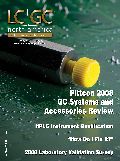Peaks of Interest-Scientists Develop Method for Identifying Gunshot Residue
Scientists Jorn Chi Chung Yu, Garrett Lee Burleson, and colleagues in the Department of Forensic Science at Sam Houston State University in Texas have developed a new method for identifying gunshot residue without the presence of lead.
Scientists Jorn Chi Chung Yu, Garrett Lee Burleson, and colleagues in the Department of Forensic Science at Sam Houston State University in Texas have developed a new method for identifying gunshot residue without the presence of lead.
Due to environmental and health concerns surrounding the use of lead, "lead-free" ammunition has become more popular, which presents a problem for forensic scientists that rely on lead-based residue tests. The new technique utilizes the analysis of gas chromatography data coupled with results from a nitrogen phosphorus detector, requires just a tiny speck of residue, and uses no extraction reagents.
"The main focus of our research is to develop a method that will help credibility of gunshot residue evidence in court. You can get results in 30 to 40 minutes with the new test. In addition you only need small amounts of evidence to run the test," Burleson said.

New Study Reviews Chromatography Methods for Flavonoid Analysis
April 21st 2025Flavonoids are widely used metabolites that carry out various functions in different industries, such as food and cosmetics. Detecting, separating, and quantifying them in fruit species can be a complicated process.
University of Rouen-Normandy Scientists Explore Eco-Friendly Sampling Approach for GC-HRMS
April 17th 2025Root exudates—substances secreted by living plant roots—are challenging to sample, as they are typically extracted using artificial devices and can vary widely in both quantity and composition across plant species.

.png&w=3840&q=75)

.png&w=3840&q=75)



.png&w=3840&q=75)



.png&w=3840&q=75)











